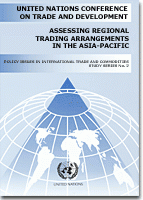
In the early 1990s when the Asia Pacific Economic Cooperation Process (APEC)was gathering momentum and the outcome of the Uruguay Round was uncertain the countries in the Asia Pacific held steadfastly to the most favoured nation principle. As a group, they intentionally avoided discussions and expansion of the existing regional trading agreements (RTA) in the region (Bora and Findlay, 1996). Since then, it appears that the enthusiasm with the ideals of the APEC has recently appeared to give way to disillusionment with the lack of progress towards achieving the ambitious objectives that were set out in Bogor. By early 2000, more than twenty regional trading arrangements (RTAs) have been proposed amongst various APEC members, and the list continues to grow. Some, such as the free-trade arrangement between New Zealand and Singapore, have already been enacted. Important research questions arise from these developments. First, there is a need for quantitative research to examine the potential effects of the proposals. Second, there is a need to understand how the new proposals might help or hinder the achievement of APEC’s ultimate objectives. This paper makes a contribution to the former.
The paper is organized as follows. Section II outlines the methods used in the "gravity Model" simulations. Section III uses the model to assess the current state of regional trading arrangements, in particular APEC sub-regional groups. This section is intended partially as a form of benchmarking, and we discuss the evidence provided by this approach in terms of the traditional features of RTAs: trade creation, trade diversion and the debate over regionalism as path towards global free trade. Section IV uses the model to analyze a subset of new proposals, in an attempt to see whether any conform to the ‘natural bloc’ criteria. We then contrast these results with those obtained by examining the same proposed blocs in a general equilibrium framework. Concluding comments follow in section V.


